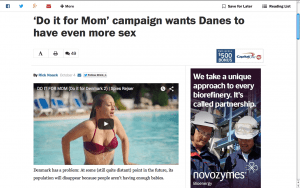To attract the attention of baby boomers with plenty of discretionary income, Spies, a Danish travel company, used cheeky humor — and a topical tie-in.

A Danish travel company is encouraging baby boomers to “send your child on an active holiday and get a grandchild within nine months.” The cheeky campaign has generated news coverage, including in the Washington Post, and lots of giggles.
The result? A funny, memorable campaign that’s made for sharing on social media and generating news coverage in its own right.
The campaign, “Do it for Mom,” encourages “wannabe grandmothers and grandfathers to ‘sponsor’ trips abroad for their adult children,” according to The Washington Post.
“Send your child on an active holiday and get a grandchild within nine months,” the company says on its website.
The approach is appealing to Danes because, as the Post notes, “Denmark has a problem: At some (still quite distant) point in the future, its population will disappear because people aren’t having enough babies.”
What makes the campaign work (and relevant to florists)? Among other things:
The Funny: The silly premise — do it for mom — makes people giggle. It also makes editors, including those at the Post, curious. “The key to funny advertising is assuring the humor is appropriate to both product and customer,” according to Mark Levit, managing partner of Partners & Levit Advertising and a professor of marketing at New York University. For additional inspiration, check out a roundup of the funniest ads of 2014, collected by the New York Post.
The Length. To promote the campaign, Spies produced a series of high quality videos, all around two to three minutes long. When it comes to videos, length matters, particularly if you want people to share the videos on social media (and, of course you do). “Shorter videos are better for getting people to watch the whole thing, which means — shorter videos produce more engaged audience,” according to Yoav Hornung, co-founder & CEO of Veed.me, a video production marketplace. Get tips from SAF CIO Renato Sogueco on how to create better videos.
The Topic. Tying an ad campaign into a larger event or issue — even in a tongue-firmly –in-cheek way — can be a good approach, and create a natural hook for reporters and editors. So-called ‘Newsjacking’ or ‘culture surfing’ “has been given a boost by social media,” according to Jane Simms, of the UK’s Marketing Magazine. “Now brands can turn emerging news to their advantage within hours with advertising that is both humorous and topical. The potential benefits are obvious: get it right, and you build consumer affinity, affection and saliency for your brand.” The downside? Get it wrong — particularly when it comes to sensitive news items — and you come across as tone deaf. Read about other examples of timely campaigns, good and bad.


